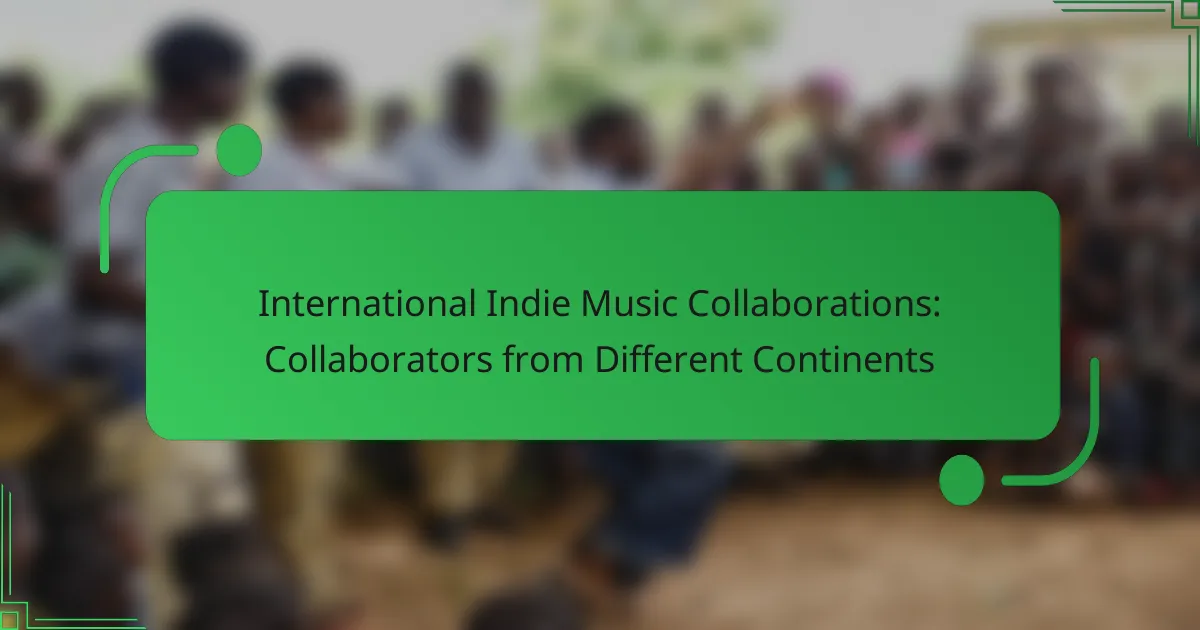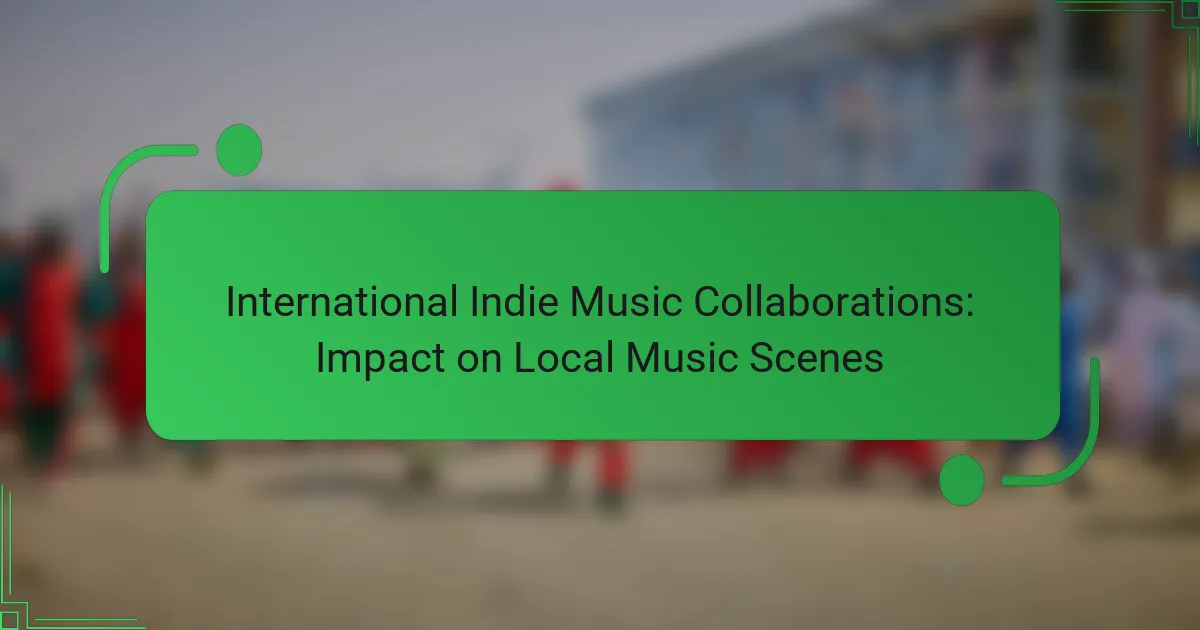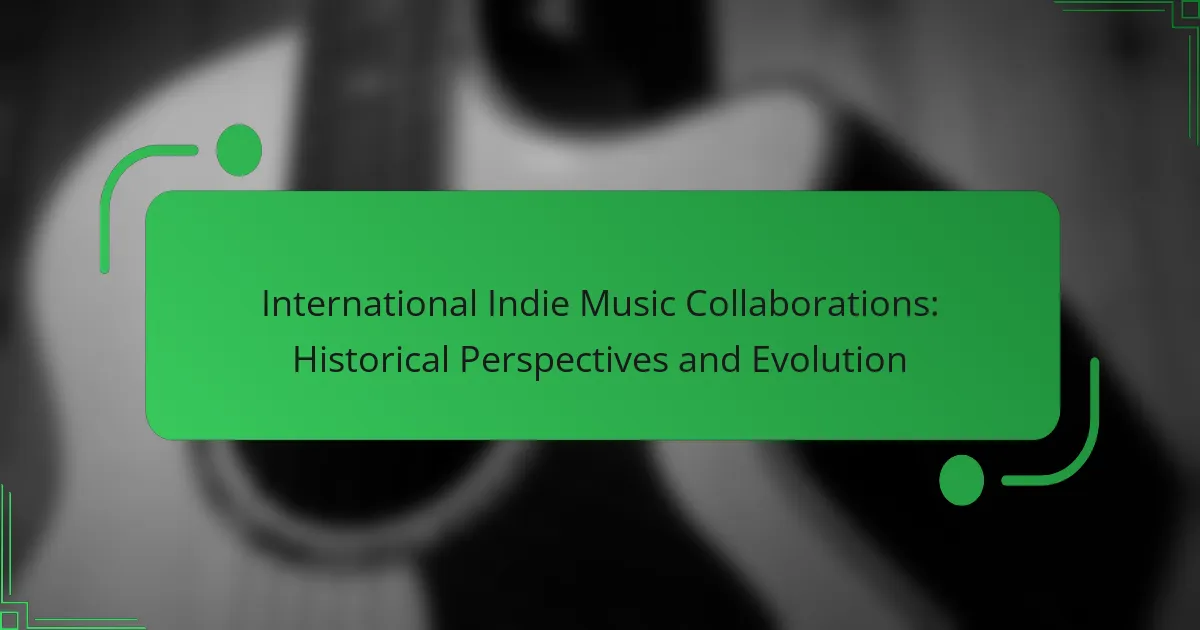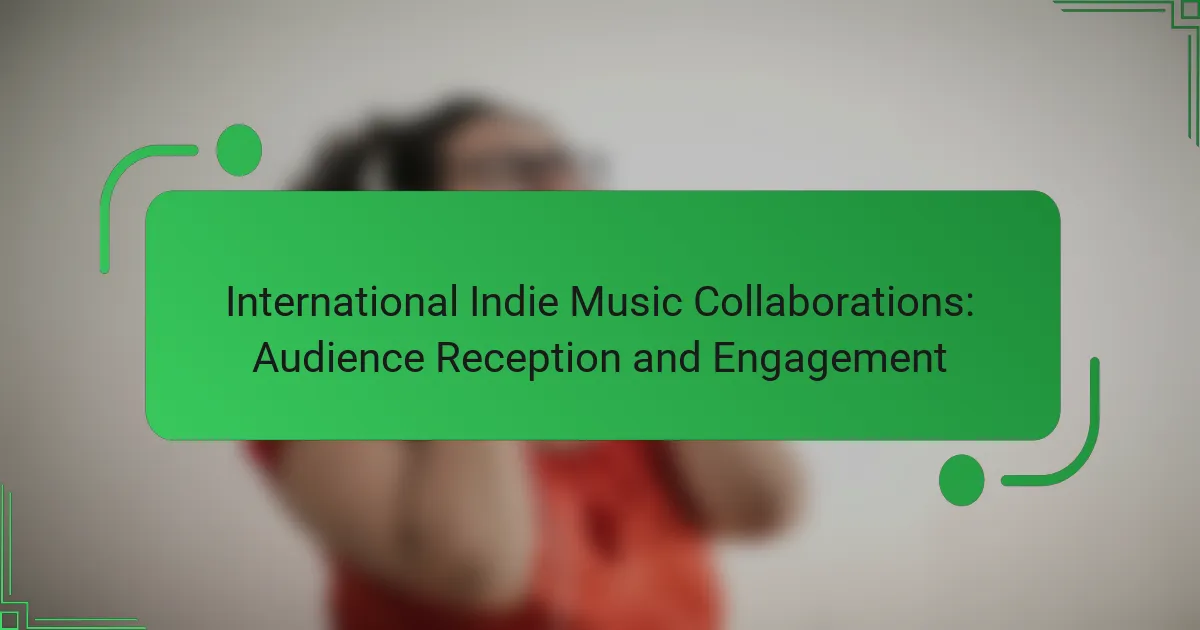International indie music collaborations are reshaping the music landscape through genre fusion, enhancing creativity and expanding audience reach. Artists blend diverse styles, merging traditional sounds with modern production techniques. However, they face challenges like cultural differences and communication barriers. Platforms like SoundCloud and Bandcamp facilitate these collaborations, allowing for innovative projects that reflect regional influences and artistic growth.
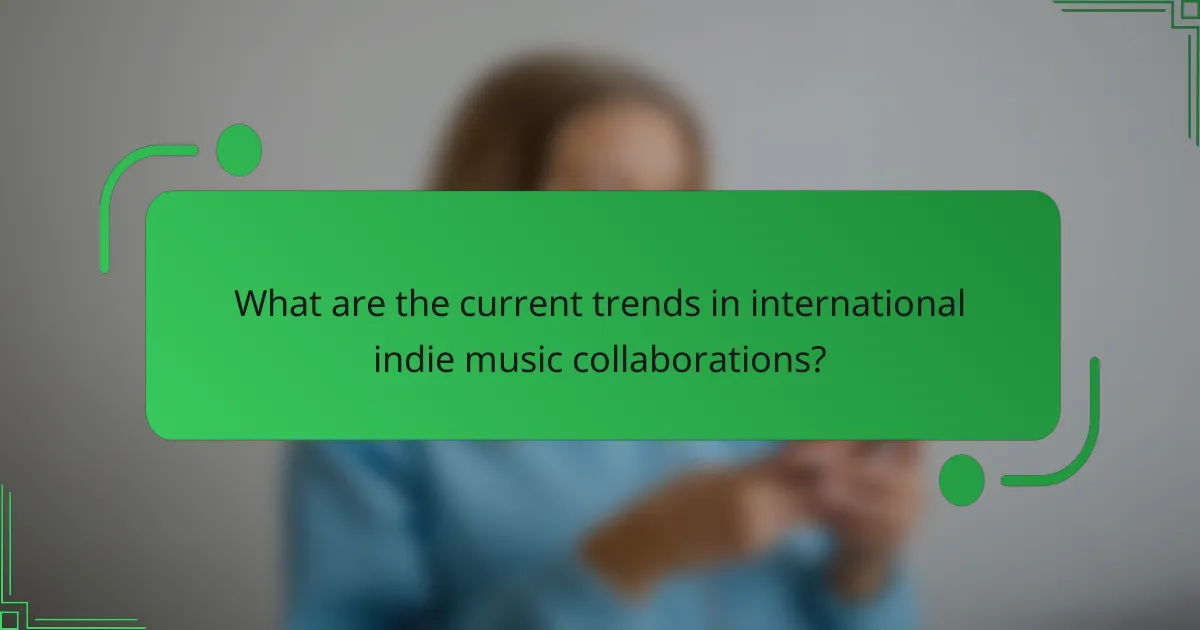
What are the current trends in international indie music collaborations?
International indie music collaborations are increasingly characterised by genre fusion, with artists blending diverse musical styles. This trend enhances creativity and broadens audience reach, as seen in collaborations that mix folk, electronic, and hip-hop elements. For example, artists from different countries are merging traditional sounds with modern production techniques, creating innovative tracks that resonate globally. The rise of digital platforms facilitates these partnerships, allowing artists to connect regardless of geographic barriers. This dynamic landscape reflects a unique attribute of the indie music scene, where cultural exchange drives artistic evolution.
How do genre fusions shape collaborative projects?
Genre fusions significantly enhance collaborative projects within international indie music. They foster creativity by blending diverse musical styles, leading to innovative soundscapes that attract varied audiences.
Collaborations often showcase unique attributes, such as the integration of traditional instruments from different cultures with modern electronic elements. This fusion can create a distinctive sonic identity, setting the project apart in a crowded market.
For example, artists from different backgrounds may combine folk melodies with hip-hop beats, resulting in a fresh genre that resonates with listeners globally. Such genre fusions not only expand artistic boundaries but also reflect the interconnectedness of today’s music scene.
As a result, genre fusion in international indie collaborations promotes cultural exchange and encourages experimentation, ultimately enriching the global music landscape.
Which genres are most commonly fused in indie collaborations?
International indie music collaborations commonly fuse genres such as folk, electronic, hip-hop, rock, and pop. These combinations create unique sounds that appeal to diverse audiences. Folk and electronic blends often emphasise acoustic elements alongside digital production. Hip-hop and rock fusions introduce rhythmic complexity and powerful instrumentals. Pop collaborations frequently incorporate various styles, enhancing mainstream appeal. This genre fusion reflects the evolving landscape of indie music, highlighting artists’ creativity and willingness to experiment.
What role do cultural influences play in genre fusion?
Cultural influences significantly shape genre fusion in international indie music collaborations. They introduce diverse musical elements, rhythms, and lyrical themes, creating innovative sounds. Collaborations often blend traditional and contemporary styles, reflecting the artists’ cultural backgrounds. This fusion enriches the music landscape, attracting broader audiences and fostering cross-cultural appreciation. For instance, artists from different regions may merge folk melodies with electronic beats, resulting in unique genre hybrids. These collaborations often highlight the global interconnectedness of music, demonstrating how cultural exchange drives creativity and evolution in the indie music scene.

How do artists benefit from collaborating across borders?
Artists benefit from collaborating across borders by accessing diverse influences, expanding their audience, and enhancing creativity. International indie music collaborations foster genre fusion, leading to innovative soundscapes. These partnerships often result in unique projects that blend cultural elements, enriching the music landscape. For example, collaborations can introduce regional instruments or traditional styles into contemporary genres, creating fresh auditory experiences. The combination of different artistic perspectives often leads to greater artistic growth and experimentation, ultimately pushing the boundaries of music.
What are the economic advantages of international collaborations?
International collaborations in indie music offer significant economic advantages. They expand market reach, enhance revenue streams, and foster innovation through diverse genre fusions. Collaborations can lead to increased ticket sales, merchandise opportunities, and shared resources. Furthermore, artists benefit from access to new audiences and promotional channels, driving growth in their careers. These partnerships stimulate local economies by attracting tourism and creating jobs in music-related sectors.
How do collaborations enhance artistic creativity?
Collaborations enhance artistic creativity by blending diverse influences and ideas. In international indie music collaborations, genre fusion emerges as a significant trend. Artists from different backgrounds combine unique sounds, creating innovative music that transcends traditional boundaries. This fusion often leads to the emergence of new sub-genres, enriching the global music landscape. Collaborative projects can also stimulate experimentation, encouraging artists to explore unconventional techniques and themes. As a result, these partnerships not only expand artistic horizons but also foster cultural exchange, inspiring audiences worldwide.
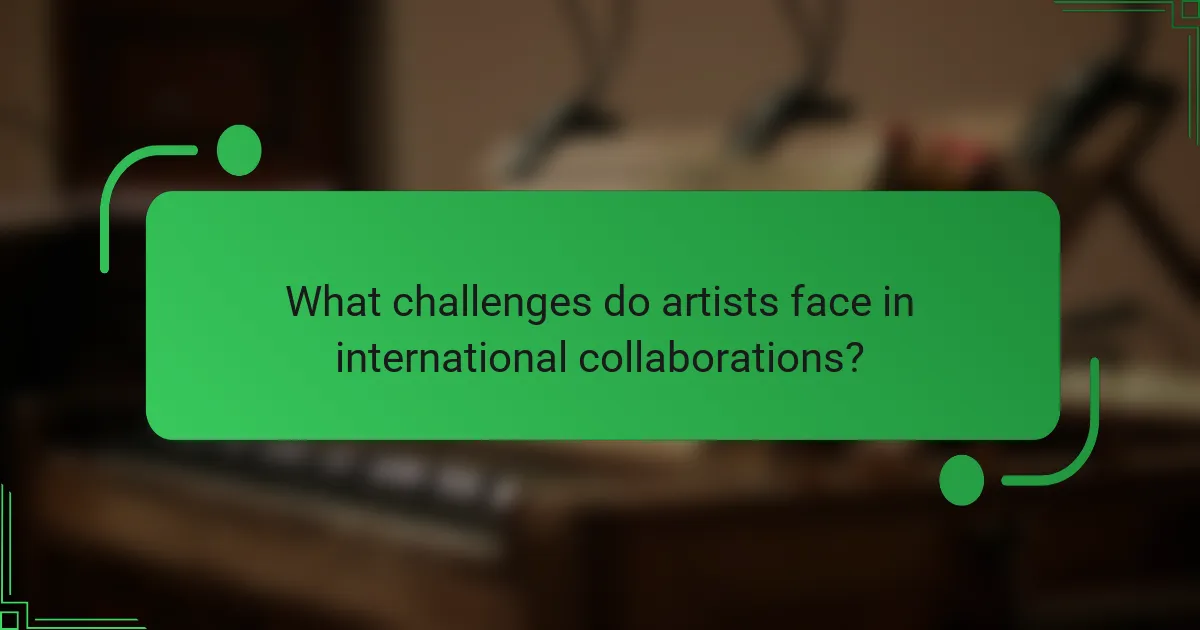
What challenges do artists face in international collaborations?
Artists face numerous challenges in international collaborations, including cultural differences, communication barriers, and varying industry standards. These factors can hinder creative processes and project management. Additionally, navigating legal issues, such as copyright and distribution rights, poses significant obstacles. Time zone discrepancies can complicate scheduling and coordination, impacting collaboration efficiency. Understanding and integrating diverse musical styles also requires adaptability and openness, which can be difficult but ultimately enriches the collaborative experience.
How do language barriers affect collaboration outcomes?
Language barriers can significantly hinder collaboration outcomes in international indie music projects. Miscommunication may lead to misunderstandings in genre fusion and artistic intent.
Collaborators might struggle to convey their ideas, impacting creativity and project cohesion. For instance, language differences can affect lyrical interpretation, resulting in a loss of emotional depth.
Additionally, collaboration tools may not effectively bridge these gaps, leading to frustration and decreased productivity. As a result, clear communication strategies are vital for successful genre fusion in music collaborations.
Establishing a common language or using translation services can enhance collaboration, ensuring all participants contribute effectively.
What logistical issues arise during cross-border projects?
Logistical issues in cross-border projects often include communication barriers, regulatory compliance, and cultural differences. These factors can hinder collaboration and project timelines. For example, differing time zones can complicate scheduling meetings. Additionally, navigating varying legal requirements can delay project initiation or execution. Addressing these challenges requires thorough planning and clear communication strategies.

Which platforms facilitate international indie music collaborations?
Several platforms facilitate international indie music collaborations. Notable examples include SoundCloud, Bandcamp, and Splice. These platforms enable artists to share music, collaborate on projects, and explore genre fusion. SoundCloud allows artists to connect globally, while Bandcamp supports direct sales and fan engagement. Splice offers tools for collaborative music production, enhancing creative possibilities across borders.
How do streaming services support genre fusion?
Streaming services facilitate genre fusion by providing platforms for diverse musical collaborations. They connect artists across genres and cultures, enabling unique blends that appeal to global audiences. For instance, Spotify’s playlists often feature cross-genre tracks, encouraging experimentation. This accessibility fosters innovation, leading to new sounds and trends in international indie music. Additionally, algorithms recommend genre-fusing tracks, promoting further exploration among listeners. As a result, streaming services play a crucial role in shaping the evolving landscape of music genres.
What role do social media play in promoting collaborative projects?
Social media significantly enhances the visibility and reach of international indie music collaborations. Platforms like Instagram, TikTok, and Twitter enable artists to share their work, engage with fans, and connect with other musicians globally. This fosters genre fusion as artists collaborate across borders, blending diverse musical styles. Recent trends reveal that social media not only promotes individual projects but also creates communities around specific genres, encouraging innovative partnerships. As a result, indie music collaborations thrive in a digital landscape where exposure leads to new opportunities and creative exploration.
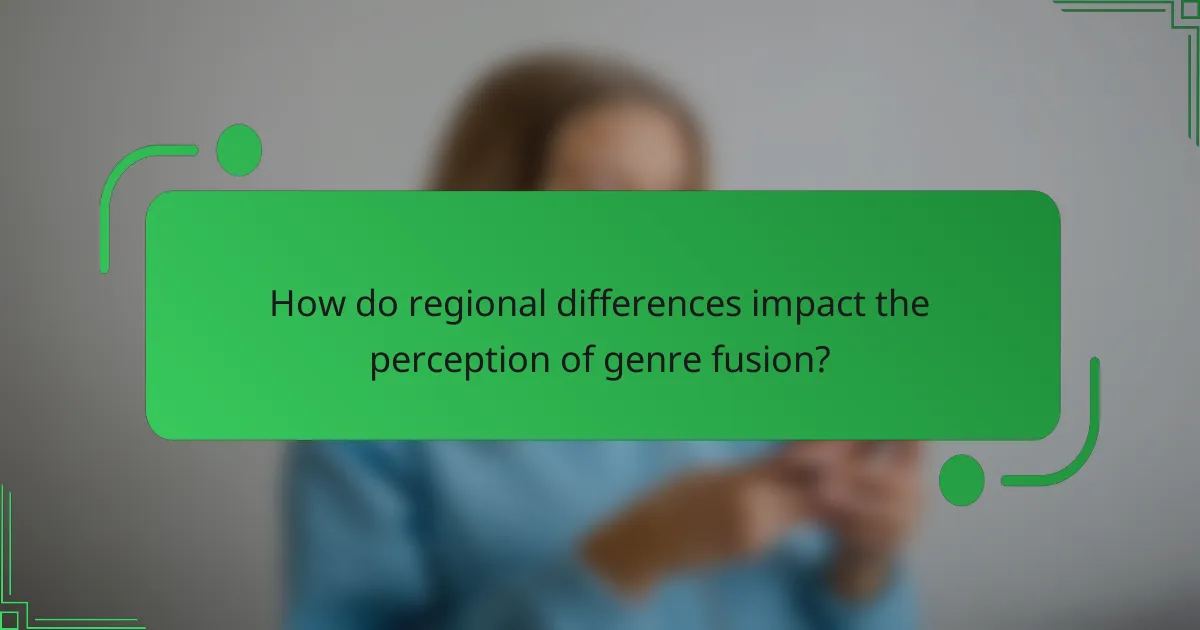
How do regional differences impact the perception of genre fusion?
Regional differences significantly shape how genre fusion is perceived in international indie music collaborations. Cultural backgrounds influence listener expectations and openness to blending genres. For instance, Western audiences may embrace eclectic mixes, while Eastern listeners might favour traditional elements. These variations can affect collaboration outcomes, determining which genres resonate more effectively. Additionally, local music scenes can impact the reception of genre fusions, as artists draw on regional influences that alter sound and style. Ultimately, understanding these regional nuances is crucial for successful genre fusion in global collaborations.
What are the unique cultural attributes influencing genre collaborations in different regions?
Unique cultural attributes significantly influence genre collaborations in international indie music. Regional musical traditions, language diversity, and local storytelling methods shape these collaborations. For instance, Latin American rhythms blend with electronic sounds in urban centres, creating a unique fusion. Similarly, African music often incorporates traditional instruments into contemporary genres, enhancing cultural authenticity. These collaborations reflect the artists’ identities and foster cross-cultural understanding, enriching the global music landscape.
How do audience preferences vary across regions for genre-fused music?
Audience preferences for genre-fused music vary significantly across regions due to cultural influences and local musical traditions. In Europe, there is a strong inclination towards blending electronic elements with traditional sounds, while in Latin America, fusions often incorporate local rhythms and instruments.
For example, in the UK, genre fusion often features indie rock combined with electronic music, appealing to a diverse audience seeking innovation. Conversely, in Africa, collaborations may merge indigenous styles with contemporary genres, reflecting a rich cultural heritage.
These regional trends highlight unique attributes of audience preferences, such as the popularity of Afrobeat in West Africa and the rise of electronic pop in Northern Europe. Understanding these variations can help artists tailor their collaborations to resonate more effectively with specific audiences.
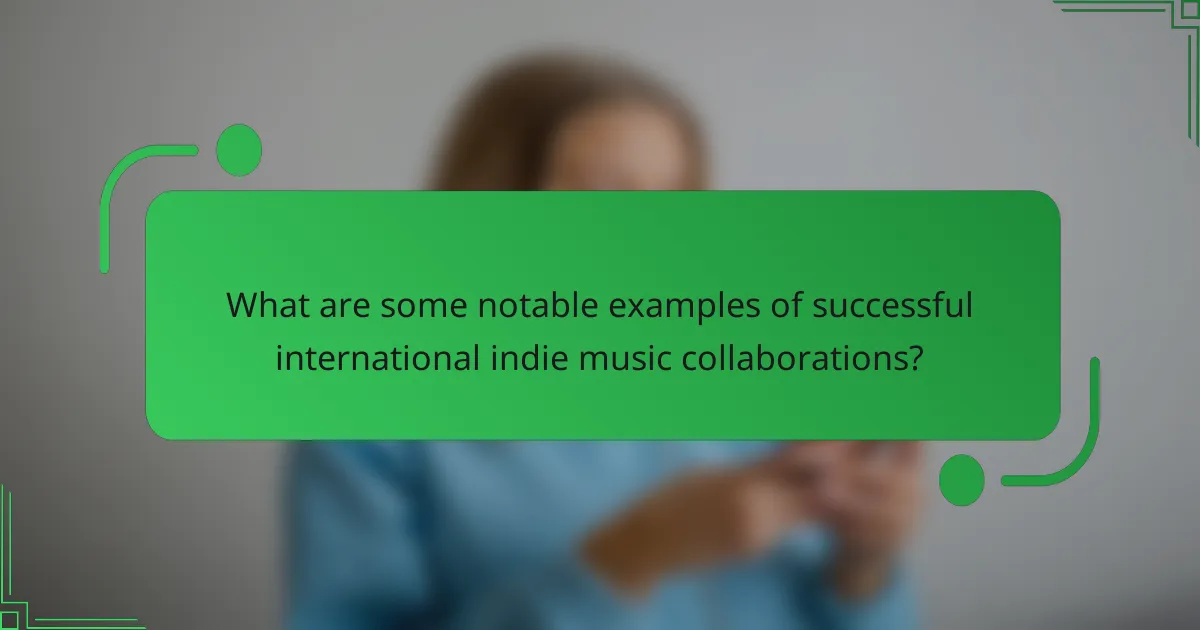
What are some notable examples of successful international indie music collaborations?
International indie music collaborations have produced notable examples that highlight genre fusion. Artists from different countries have come together, blending diverse musical styles to create innovative sounds.
One prominent example is the collaboration between the British band Alt-J and the Senegalese musician Baaba Maal. Their track “The River” combines indie rock with traditional African rhythms, showcasing unique cultural influences.
Another example is the partnership between the American singer-songwriter Sufjan Stevens and the Australian artist Sufjan Stevens. Their joint project, “Aporia,” merges folk and electronic elements, resulting in a fresh auditory experience.
Additionally, the collaboration between the Canadian artist Grimes and the Japanese musician Kero Kero Bonito demonstrates a successful fusion of synth-pop and J-pop, appealing to a global audience. These collaborations exemplify the trend of international indie music artists pushing creative boundaries through genre fusion.
Which collaborations have significantly influenced genre fusion trends?
International indie music collaborations have significantly influenced genre fusion trends by blending diverse musical styles and cultures. Notable examples include the partnership between Bon Iver and James Blake, which merged indie folk with electronic elements, and the collaboration of Gorillaz with various international artists, showcasing global sounds. These collaborations often result in innovative sounds that challenge traditional genre boundaries. The unique attribute of genre fusion in these collaborations creates fresh listening experiences, attracting wider audiences and inspiring new artists.
What lessons can be learned from these successful projects?
Successful projects in international indie music collaborations highlight key lessons in genre fusion. These projects demonstrate the importance of cultural exchange, creativity, and adaptability.
Collaborations often lead to innovative soundscapes that blend diverse musical styles, attracting wider audiences. For example, artists combining Afrobeat with electronic music have created unique tracks that resonate globally.
Additionally, effective communication among collaborators fosters a shared vision, enhancing the creative process. This synergy often results in high-quality productions that reflect the strengths of each artist involved.
Finally, leveraging digital platforms for distribution amplifies reach and engagement, showcasing the benefits of collaboration in the modern music landscape.
How do emerging artists leverage collaborations to gain visibility?
Emerging artists leverage collaborations to enhance visibility through genre fusion, expanding their reach and audience. Collaborations allow artists to tap into each other’s fan bases, increasing exposure. For example, blending pop with hip-hop attracts diverse listeners. This trend fosters innovation, as artists experiment with new sounds and styles. Collaborations often lead to increased streaming numbers and social media engagement, further amplifying visibility.
What are the best practices for artists considering international collaboration?
Artists should prioritise clear communication, cultural understanding, and shared goals when considering international collaborations. Establishing a mutual vision enhances creative synergy.
Building a diverse network of global contacts can facilitate unique genre fusions, expanding artistic horizons. Embracing technology for remote collaboration can streamline the process and enhance productivity.
Additionally, understanding the legal aspects, including copyright and distribution rights, is crucial for protecting all parties involved. Regular feedback loops throughout the collaboration can ensure alignment and foster innovation.
